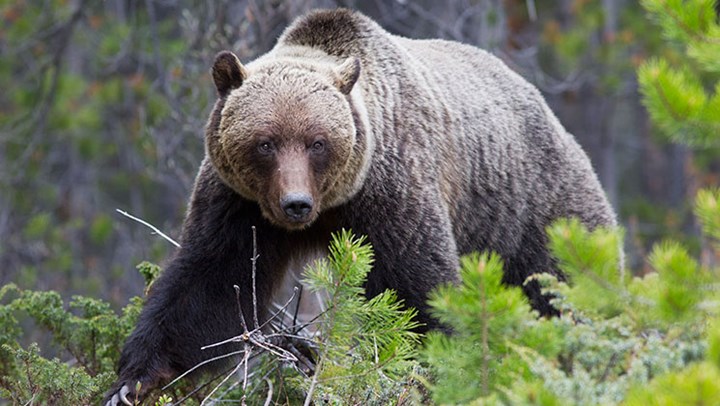
by Karen Mehall Phillips - Tuesday, September 4, 2018

With grizzly bear populations recovered in the Greater Yellowstone Ecosystem (GYE) and removed from Endangered Species Act (ESA) protections, Sept. 1 was to be the opening day of the first grizzly bear hunts in Wyoming and Idaho in decades. Instead—two days before the season openers—attorneys for the U.S. Fish and Wildlife Service (USFWS), NRA and SCI were in a hearing in federal court in Missoula, Mont., to fight for hunter-conservationists against animal rights groups that filed suit to challenge the Trump administration’s removal of ESA protections. Defendants made strong arguments in defense of the delisting and the use of hunting as a science-based grizzly-bear management tool. During the hearing U.S. District Judge Dana L. Christensen said he would make his decision on the delisting as soon as possible. So far, so good. But the next morning, on Aug. 31, Christensen buckled to animal-rights extremists and issued a 14-day temporary restraining order against the hunts to deliberate further.
As reported by the Washington Post, Judge Christensen wrote, “The threat of death to individual grizzly bears posed by the scheduled hunt is sufficient" to warrant a delay. The order provides a temporary reprieve for as many as 23 Yellowstone National Park-area bears. The majority are to be hunted outside Yellowstone and Grand Teton National Parks in Wyoming, including up to 22 bears, with Idaho’s quota set at one male grizzly.
Judge Christensen issued the order following motions filed after the hearing by some of the plaintiffs in the grizzly bear delisting case. As SCI also shared, the court did not wait to allow briefs from the defendants—the USFWS; the states of Wyoming, Idaho and Montana; and non-governmental organizations including the NRA and SCI—before ordering that the hunts be put on hold.
Background on the Delisting
Federal officials first removed protections for grizzly bears in the Greater Yellowstone Ecosystem (GYE) in 2007, only to have animal rights extremist groups file suit to keep the delisting tangled up in court. Finally, in 2017 Secretary of the Interior Ryan Zinke announced the recovery of GYE grizzly bears, defining it as “one of America’s great conservation successes—the culmination of decades of hard work.” The collective hunting and conservation community celebrated that the iconic species of the West no longer needed ESA protections. But as this website has noted numerous times, animal rights extremists continue to use emotional appeals and portray the multiple problem bears that are killed in self-defense or by wildlife officials as victims. This careless move puts the bears’ welfare before human safety and ignores a critical fact: Populations of predator and prey species alike must be kept in check. Protecting and managing wildlife through science-based hunting regulations can and do produce sustainable wildlife populations.
This is why the Washington Post article notes that “federal and state officials say that hunts, which must adhere to mortality limits set forth in conservation plans, will not threaten the overall grizzly bear population and might help it by increasing tolerance for the predators among ranchers and other residents concerned about their spread.” In addition, federal scientists and hunter-conservationists now point to an additional safety problem regarding grizzly bears: “The bears have switched to meat from livestock to remains left by elk hunters, leading to rising human-caused deaths.”
Truth Twisters
So once again, the collective hunting community must wait and see what comes next as animal rights extremists work to shut down hunting as America’s No. 1 wildlife management tool. Of course, they will continue twisting the truth about the critical role of legal, regulated hunting and the fact that grizzly bear populations by far exceed the population goals that were established by wildlife officials as guidelines for keeping the bears listed under the ESA. How else could they make their case? This is precisely how they gain traction with non-hunters who simply have never been exposed to our all-American hunting traditions and hunting’s benefits to wildlife, conservation and habitat enhancement.
For now the only thing we hunters—and the NRA, SCI and every other hunter-backed conservation group—can do is voice our disappointment with Judge Christensen’s decision and await further updates. In the meantime, we hunters will continue to do what we do: Go afield and funnel millions of dollars into maintaining healthy game populations; help to preserve wildlife’s natural habitats; and, of course, feed our families the best high-protein, low cholesterol game meat, some of which will be shared with those less fortunate through donations of venison to local Hunters for the Hungry programs.
For more details on this issue, visit these NRAHLF.org story links:
• Wyoming Proposes 2018 Grizzly Bear Season
• Debunking the Yellowstone Grizzly Delisting Lawsuits
• "Delisting" of Grizzlies is Not a Dirty Word
• Anti-Bear-Hunting Billboard Targets Yellowstone Park
• Hunters May Soon Get Grizzly Bear Tags in the Greater Yellowstone Area
• USFWS Proposes Delisting the Grizzly Bear in the Greater Yellowstone Ecosystem
E-mail your comments/questions about this site to:
[email protected]
Proudly supported by The NRA Foundation and Friends of NRA fundraising.
